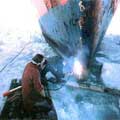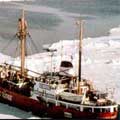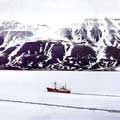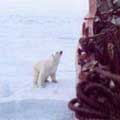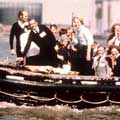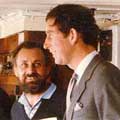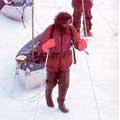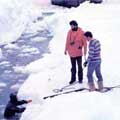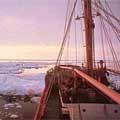Ship’s Stories: Homecoming
“Though the Benjamin Bowring is not an ice-breaker” said Les Davis, her Master, “she was designed to operate in ice, and does so pretty well. Her bows are specially strengthened for it, and when I saw her in dry dock after the Antarctic leg, where we did a good bit of bashing, there wasn’t a dent in her”.
“Mind you I wouldn’t say she hasn’t got a few now, because the bashing in the Arctic was a lot more severe. In any case, the Antarctic sea-ice is generally much less testing than the Arctic, where it is often much older and therefore deeper and harder. Nor has she particularly powerful engines. Eight-and-a-half knots is about her maximum cruising speed. But in the Antarctic she showed up very well in comparison with the SAS Agulhas, a bigger and more powerful ship, and in the Arctic did everything we could have expected of her, and more”.
During the latter part of April, Ran Fiennes and Charlie Burton made such spectacular progress southward from the Pole, that the London Committee considered that it would be wise to stick to the ship’s original schedule, and aim to arrive at Svalbard by 1st May. This was not to be, because she made an abortive start from Southampton, and had to put back for further attention to her engines. She eventually sailed on April 30th past much larger vessels frantically loading for the Falklands; and ironically turned northwards towards a destination almost as far from the Falklands war as it is possible to get.
We arrived (writes Antony Bowring) off the Spitzbergen coast on 8th May, only to be confronted by a long tongue of ice which seemed to stretch from the southern tip of the island all the way up the west coast, blocking access to the settlement of Longyearbyen where we were to establish ourselves. It is desperately frustrating hunting for a gap in sea ice, even with the advantage of a crow’s nest to increase the visible horizon and see over the nearer floes. We made an attempt to get through it but it was heavier and harder than anything we had met in the Antarctic, and after about a mile we literally came to a grinding halt. There was nothing for it but to retrace our route to open water, where we continued our northward route and eventually rounded the tip of the tongue.
Isfjorden was clear of ice apart from a few scattered floes. The air was very still, and although it was still “night-time” the sun shone down on the snow-covered mountains through a thin film of cloud. In the early hours of the morning we entered Advent Bay and saw the huts and buildings of Longyearbyen. The bay was still covered with ice — we were the first ship to arrive since the previous autumn — and though our bows chipped their way through it we failed by 200 yards to get alongside the quay. It was, however, thick enough to walk on and so we were able to go ashore.
Svalbard is the name of a group of islands to the north of Norway which include Bear Island and Jan Mayen. Spitzbergen is the largest of these islands, 240 miles long, with a forbidding cliff – and glacier-bound coast. Temperatures fall to -40°C and rise to only four degrees above freezing, so that the soil is permanently frozen, and only a shallow soft layer in summer bears a ground-hugging and meagre vegetation. Also in summer boggy meltwater pools form on any flat stretch of land and short-lived muddy streams bubble down from the hills.
Longyearbyen, the capital, owes its existence to coal deposits, and almost all the 1,000 population work for the Norwegian State mining concern. There is a shop, a post office, a church, assembly hall and cafeteria. There is also an airport under the control of the senior Norwegian administrator, but with a permanent Russian Aeroflot establishment, whose members are believed by all the inhabitants to be operatives of the KGB. There is an uneasy truce between the top Russian and the Norwegian Administrator (said Les Davis), and the Russians are continuously trying to pre-empt the Norwegian’s duties by officiously examining passports and even trying to collect them – even though the Norwegian is the only authority who can deal with them and hand out permissions.
The islands have an interesting history of travel and exploration. They were discovered by the Dutch in 1596 and some twenty years later the first whaling settlements were set up, though they were occupied only during summer. The Russians first arrived in the early 1700’s, and started a summer trade in pelts of reindeer, Arctic fox and polar bear. They were the first to winter there, though many of the earlier inhabitants are reputed to have been convicts reprieved from the gallows or the axe and who (say the locals) would almost certainly have chosen to die had they known what Spitzbergen in the winter was then like.
More recently Svalbard has been the starting or finishing point for a number of polar expeditions, several of them airborne. Amundsen and Ellesworth flew from there to Alaska via the Pole in an airship in 1926. Richard Byrd made a similar flight in the same year, and two years later the Englishman George Wilkins flew in the opposite direction. Since then “expeditions” have posed a problem for the administration. Every year a growing number of visitors fly in to Longyearbyen intending to explore and ski on the mountains and glaciers. Unless they have brought suitable equipment, including survival gear, food and means of carrying it, they are sent back on the same plane. Search and rescue operations are costly, dangerous, time-absorbing and doubtful in their outcome. At the beginning of this year, for instance, a Spanish Expedition arrived. They intended, they said, to proceed to the Pole on motorcycles (which they had with them) towing their tents and provender behind them on sledges. Fortunately they did not get far beyond their campsite close to the airport without falling off their bikes enough times to convince them that the project was not feasible.
Thus Transglobe’s first welcome was full of suspicion and not exactly warm. However, the authorities were soon more favourably impressed, not only with the Benjamin Bowring herself, but also with the equipment they landed, including a V-8 Landrover, a 20-ft. Portakabin which Eddie Pike the ship’s carpenter had fitted up with five bunks, tables and benches, and became co-operative and friendly. The hut was set up on the campsite by the aerodrome, and with the aid of a generator became our base camp/radio station.
At this stage the Russians became convinced that the Benjamin Bowring was a spy-ship. They dared not approach too closely or directly. In fact (said Les Davis) they would make a slow advance backwards in case anyone might think that they were being too friendly, which might have got them into trouble at home, were it reported. When they got near enough they would turn round for a quick look and then beat a hasty retreat. All this was very entertaining, both for Transglobe and the Norwegians.
They also established a dump at the base camp for the stores they had brought for the ice party, and which would be picked up by Karl Zberg in the Chubb Twin Otter and delivered to them as necessary.
The communications network was at this stage the most extensive and effective the Expedition had enjoyed. It was possible for “The Hut” to communicate with the ship, the aircraft, the base camp at Station Nord where Virginia Fiennes and Simon Grimes still were, and, at times, with the ice party. There was also a direct telecommunications link with London, and everything was ready for Ginny to join them, but she had to stay at Nord until Ran and Charlie had floated far enough south for direct communications between them and “The Hut” to become completely reliable.
The Benjamin Bowring stayed at Longyearbyen for eight weeks, and during this time made two forays to the north to see how the ice was breaking up and to familiarise the crew with the environment. They were surprised to see how solid the ice was. The floes were massive both in area and depth. Some were several miles in extent, and beneath the surface they could see inverted pinnacles disappearing 30 feet down into the darkness. They soon learned which of the floes it might be possible to break up. The hard blue-green ice of the older floes was like granite, and the ship’s bows made no impression. Indeed, engineers Howard Wilson and Ken Cameron had on one occasion to weld up a small crack in the hull.
The leads between the floes were filled with soft porridge ice which could neither be walked on nor rowed through. Benjamin Bowring’s crew became fully convinced that Ran’s decision to float had been the correct one, and that to move prematurely from their floe would have been extremely rash.
As the weeks passed by, however, and in spite of the fact that the ice team were most often floating south at about 3 miles a day, the mood of the London Committee seemed to become more anxious, and the messages they sent urged Ran, more and more pressingly, to fly out while he could. They pointed out that summer temperatures would soon make it impossible for the aircraft to land on the floe, the surface of which would become too wet and bumpy. The Expedition’s objectives had been achieved, they said, in that both Antarctica and the Arctic had been crossed.
But every active member of the Expedition knew that its object was a surface circumnavigation of the world, and an airlift at the end, no matter if it were only for 150 or 200 miles, would invalidate it, certainly in Ran’s eyes and in those of the rest of the team, if in nobody else’s. The Committee’s argument seemed to be based on the fear that if neither the aeroplane nor the Benjamin Bowring succeeded in picking up the ice team, the eventual rescue operation that would have to be mounted would be so costly as to involve the Expedition in an unsurmountable debt, and would involve so much adverse publicity, that the efforts of the team members, and the contributions made by the sponsors might have proved valueless.
Antony Bowring writes convincingly: “It was inevitable that members of the Expedition in the field and their advisers in London should, at that stage, have different views. In the field it was possible to study conditions at first hand, and to remain assured that all was going reasonably well, albeit slowly. In London our advisers could only read reports of ice movement, temperature, wind speed and direction. Two wholly different sets of reactions developed from these circumstances. In the field there was optimism, while in London there was growing concern. Had both parties had the opportunity to discuss the situation, a common mood might have emerged.
“As it was we knew that, in time and with perseverance, we had a very good chance of taking the ship to a spot close to Ran and Charlie. We knew they would eventually have to leave the floe, but only if we could give them a distance of something less than 20 miles of alternating floe and open water to cross in what had always been recognised as the final and most dangerous stage of the whole journey.”
Captain Les Davis made several trips with Karl Zberg in the Twin Otter to see how the ice was breaking up. Then, from London, came a report that a satellite picture had revealed that there was a break in the ice almost as far as the floe where the ice party were floating. The Benjamin Bowring set out to find it, but conditions did not tally with the report and after 60 miles they had to turn back to avoid getting stuck in the ice.
Eventually, perseverance paid off. It was a case of third time lucky. With only a small improvement in conditions, Les Davis decided to make for the edge of the ice pack, there to lay off until a way through opened up. At first they were continually blinkered by fog that formed from the relatively warm summer air and the cold water. They made progress whenever they could, and stopped when they could not see the ice around them.
When visibility allowed, the Twin Otter would fly out to guide and advise them. In clearer weather open leads were often identifiable from the ship by a dark reflection on the low cloud. Making their way towards them could often take hours. Progress between the larger floes was hampered by wedges of ice small enough to be pushed under by the bows, but too tough to break. They had to be nudged aside by the bows and swept past by the draw of water from the propeller – a frustrating business that took considerable skill. Slowly and surely they moved into the ever-changing icescape, gradually gnawing away at the edges of the floes barring their progress. “The shuddering and grinding of the hull” writes Antony, “was a constant accompaniment, the lurch as we struck a new floe often threw us off our feet.”
As they got closer the mood on board became more and more cheerful and triumphant. On a day when the clouds were high and visibility good Karl Zberg reported that he was flying over Ran and Charlie and could see the Benjamin Bowring at the same time. When they were fifteen miles away Ran finally decided that it was time to leave the floe where he and Charlie had spent 99 days. Antony Bowring again: “They set off hauling their heavily laden canoes over the hummocks and paddling them across the open leads. The sun occasionally broke through. Snow was falling gently and it was cold. Ran reported that he could see the masts of the ship in the distance.
‘Everyone on board was up and about. Jim Young (the New Zealand Engineer) climbed the mast. It was the most exciting moment of the three-year journey, and nobody wanted to miss it. The ship crawled on through boulders of ice which gave only just enough room to let us through, while Ran and Charlie heaved their loads towards us. There was a good fresh breeze from the north, and the ice was still moving just enough to let us through.
“While we were still five miles away Jim Young spotted Ran and Charlie from the masthead, and everyone searched the distance through their binoculars. Finally we picked out the two tiny specks, which disappeared and reappeared from behind the huge blocks ot ice which cluttered the horizon.
“The ship finally came to a stop only seven miles from the floe Ran and Charlie had left. Before long the two of them were visible to the naked eye, straining at their harness, backs bent. With less than half a mile to go Ran stopped and Charlie came up beside him. Ran busied himself with the cover of his boat and before long had a Union Jack flying from a short mast. He then put himself back in harness and covered the very last short lap.
“From the loud speakers on the ship we played the Eton Boating Song and Land of Hope and Glory. There was cheering and shouting from the ship (much of it unprintable) until eventually they stood tiredly by the ship’s side, and the bellow of Charlie’s laugh exploded above the cheers.
“Ten years ago it was just an idea. Ten years of hard graft had brought us all to this moment on 4th August, 1982 at 0014 hrs. in the middle of a vast expanse of Arctic ice at 80° 31’ N and 0° 59’ W. The work was done, and it was entirely fitting that the ice team, base camp personnel, aircraft and ship, and their crews had all played an essential role in making the rendezvous possible.”
They were stuck in the ice for a further ten days, floating southward on the current as Ran and Charlie had for the previous ninety-nine. Eventually, however, the ice opened again, and with advice from Karl Zberg they found a way through, reaching Spitzbergen in less than a day.
The journey home to the eastern end of the Thames estuary was remarkable (apart from the general air of euphoria) only for the fact that the Benjamin Bowring averaged 10 knots without being pushed – well above her normal cruising speed. Cyrus Balaporia, her First Officer, said matter-of-factly: “She always does that, puts on a bit of speed when she’s coming into port for a bit of a rest. All ships have special characters you can’t explain, and the older they get the more they show it.”
Cyrus was born in Bombay, and as soon as he was old enough and had the right educational qualifications, joined British India Steam navigation Company in which his father and an uncle had also served. He had just acquired his Master’s ticket when he applied to join Transglobe, in 1978, in answer to an advertisement. You get the impression that he has a mild love affair with every ship he serves in.
“Why did I do it? I’ve always been fascinated with ice, and was determined to see it and learn about it. Perhaps it was because I was born and grew up in a hot country – the cold always attracts us, we feel better in it. The same way that you British seem to thrive in hot countries and are always looking for the sun. Now that this is finished, I shall stay in England for a bit and get another job as fast as I can. I’ve lost about £56,000 in wages in the four years, but for me personally, it was worth it. My father always told me I should do what I want to do while I’m young enough. That way you don’t grow old with regrets.”
His startling figure of £56,000 prompted us to check with Les Davis what it would have cost a shipping company in crew’s wages to prepare the Benjamin Bowring for sea and keep her there for three years. The figure came to about £450,000, which places her volunteer crew and the other Transglobe volunteer support workers among the most important commercial sponsors of the Expedition.
During her first day off Southend the Benjamin Bowring was discovered by the Press, and the frantic efforts of the crew and expedition members to renew some of her inboard paint and remove the rust marks for her final trip to Greenwich were continually interrupted by a series of TV, Radio and Press interviews, which had to be conducted from tugs and launches, since nobody, had they climbed on board, would have been allowed ashore again until after Customs and Immigration formalities had been completed.
Finally, however, she was able to steam, her bright red hull and white superstructure gleaming in the late Summer sunlight, to her rendezvous with HRH the Prince of Wales in Galleon’s Reach, and thence, with her Patron on board, to journey’s end at Greenwich – only four days earlier than had been planned six years before. Remarkable timing for the end of a remarkable adventure.

